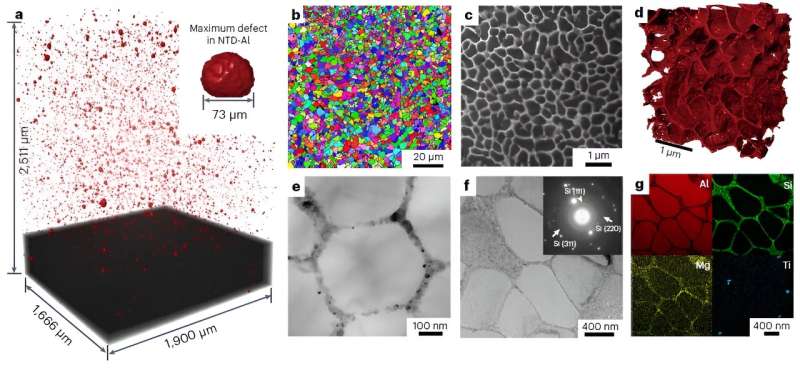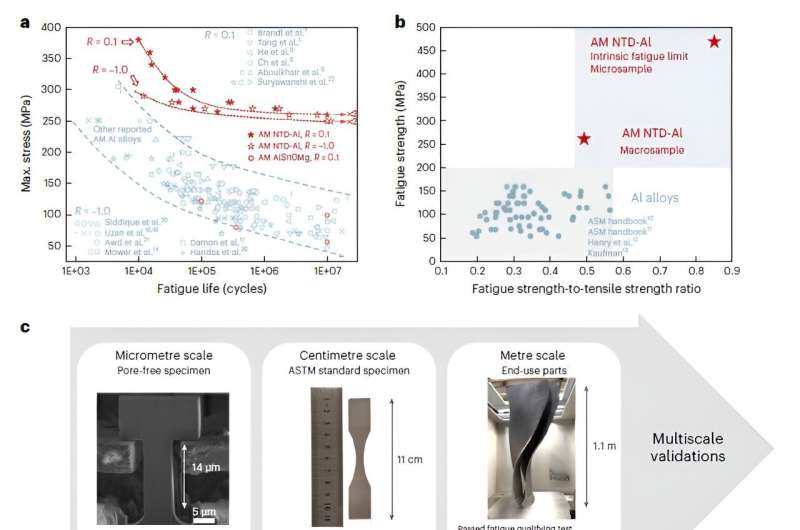This article has been reviewed according to Science X's editorial process and policies. Editors have highlighted the following attributes while ensuring the content's credibility:
fact-checked
peer-reviewed publication
trusted source
proofread
Team creates 3D-printed aluminum alloy with unprecedented fatigue resistance

It is estimated that more than 80% of engineering failures are due to material fatigue, so the fight against metal fatigue failures continues, as this is a key parameter for lightweight structures for all mechanical systems, such as aircraft, automobile and energy-production systems.
Recently, joint research by City University of Hong Kong (CityU) and Shanghai Jiao Tong University achieved a breakthrough by creating an aluminum alloy with unprecedented fatigue resistance using advanced 3D printing techniques. The new fatigue-resistance strategy can be applied in other 3D-printed alloys to help develop lightweight components with increased load efficiency for various industries.
"The fatigue phenomenon in metals was discovered about two centuries ago. Since then, fatigue failure has become one of the most important issues in the lifespan and reliability of all dynamic mechanical systems, such as those in aircraft, automobiles and nuclear power plants," said Professor Lu Jian, Dean of College of Engineering, and Director of the Hong Kong Branch of the National Precious Metals Material Engineering Research Center (NPMM) in CityU, who co-led the research.
Conventional metals exhibit fatigue strength generally lower than half their tensile strength. "Low fatigue strength is caused mainly by multi-scale defects in the materials, which continue to grow and evolve with cyclic loading, forming macroscopic cracks and expanding eventually into larger cracks that destroy the entire material structure," he explained. "This challenging phenomenon also happens in alloys produced by additive manufacturing, also known as 3D-printing, limiting further applications of 3D-printed materials."
To overcome the issue of low fatigue resistance in 3D-printed alloys and generally in all metal materials, a joint-research team of CityU and Shanghai Jiao Tong University used Laser Powder Bed Fusion (LPBF)—one of the most widely used metal additive manufacturing techniques—to successfully fabricate a novel aluminum alloy from AlSi10Mg powders decorated with TiB2 nanoparticles. The fatigue resistance of this 3D-printed nano-TiB2-decorated AlSi10Mg (NTD-Al alloy) is more than double that of other 3D-printed aluminum alloys and surpassed those of high-strength wrought AI alloys.
These findings were published in Nature Materials under the title "Achieving ultrahigh fatigue resistance in AlSi10Mg alloy by additive manufacturing," and they were featured in the "Research Highlights" of the journal Science, which described it as a general strategy for other alloys to boost fatigue resistance.

The team used micro-computed tomography to investigate this 3D-printed NTD-Al alloy and found throughout the sample a typical continuous 3D-dual-phase cellular nanostructure, which consisted of a network of solidification cellular structure with an average diameter of about 500 nanometers. The 3D-dual-phase cellular nanostructure acts as a strong volumetric nanocage to prevent localized damaged accumulation, inhibiting fatigue crack initiation.
"The three-dimensional network of nano eutectic silicon (Si) generated by additive manufacturing inside the alloy due to rapid solidification could block the movement of dislocations, thus suppressing fatigue crack initiation," said Professor Lu. "With controlled defects through process optimization, the fatigue limit of the bulk NTD-Al alloy is superior to that of all existing Al alloys."
In a series of fatigue tests, the research team found that the printed bulk NTD-Al alloy achieved fatigue resistance of 260 MPa, which was more than double that of other additive manufacturing Al alloys. The high fatigue strength limit of the bulk NTD-Al alloy surpassed that of all other Al alloys, including conventional high-strength wrought Al alloys with limited metallurgical defects.
The NTD-Al alloy has already been applied to fabricate prototypes of large thin-walled structures, including the fan blades of aircraft engines designed for high fatigue strength, and successfully passed the qualifying fatigue test.
"These findings indicate the potential applicability of our alloy for the lightweight structures necessary in industries where fatigue properties are the key design criterion. Our alloy can help reduce weight by increasing the load efficiency of moving components," added Professor Lu.
"Combined with the advantages of 3D printing, the latest discovery will boost lightweight design and reduce carbon emissions in modern industries. And the same strategy can be also used for other materials to help solve the fatigue failure challenge in metal additive manufacturing," concluded Professor Lu.
More information: Chengyi Dan et al, Achieving ultrahigh fatigue resistance in AlSi10Mg alloy by additive manufacturing, Nature Materials (2023). DOI: 10.1038/s41563-023-01651-9



















